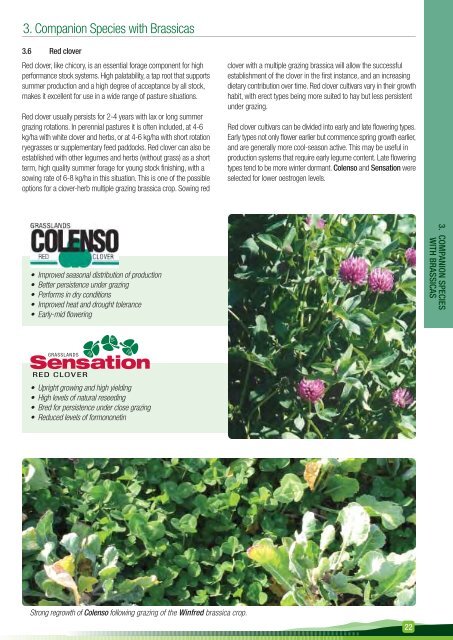Brassica Reference Manual - Agricom
Brassica Reference Manual - Agricom
Brassica Reference Manual - Agricom
You also want an ePaper? Increase the reach of your titles
YUMPU automatically turns print PDFs into web optimized ePapers that Google loves.
3. Companion Species with <strong>Brassica</strong>s<br />
3.6 Red clover<br />
Red clover, like chicory, is an essential forage component for high<br />
performance stock systems. High palatability, a tap root that supports<br />
summer production and a high degree of acceptance by all stock,<br />
makes it excellent for use in a wide range of pasture situations.<br />
Red clover usually persists for 2-4 years with lax or long summer<br />
grazing rotations. In perennial pastures it is often included, at 4-6<br />
kg/ha with white clover and herbs, or at 4-6 kg/ha with short rotation<br />
ryegrasses or supplementary feed paddocks. Red clover can also be<br />
established with other legumes and herbs (without grass) as a short<br />
term, high quality summer forage for young stock finishing, with a<br />
sowing rate of 6-8 kg/ha in this situation. This is one of the possible<br />
options for a clover-herb multiple grazing brassica crop. Sowing red<br />
Strong regrowth of Colenso following grazing of the Winfred brassica crop.<br />
clover with a multiple grazing brassica will allow the successful<br />
establishment of the clover in the first instance, and an increasing<br />
dietary contribution over time. Red clover cultivars vary in their growth<br />
habit, with erect types being more suited to hay but less persistent<br />
under grazing.<br />
Red clover cultivars can be divided into early and late flowering types.<br />
Early types not only flower earlier but commence spring growth earlier,<br />
and are generally more cool-season active. This may be useful in<br />
production systems that require early legume content. Late flowering<br />
types tend to be more winter dormant. Colenso and Sensation were<br />
selected for lower oestrogen levels.<br />
22<br />
3. COMPANION SPECIES<br />
WITH BRASSICAS


